exam questions with answer ,class notes
EXCELLENT HOMEWORK HELP AND TUTORING ,ALL KIND OF QUIZ AND EXAMS WITH GUARANTEE OF A
Am an expert on major courses especially; psychology,Nursing, Human resource Management and Mathemtics Assisting students with quality work is my first priority. I ensure scholarly standards in my documents and that's why i'm one of the BEST GOLD RATED TUTORS in STUVIA. I assure a GOOD GRADE if you will use my work.
- 208
- 0
- 1
Community
- Followers
- Following
206 items

PRINCIPLES OF HISTORY TAKING AND PHYSICAL EXAMINATION HAMAD AL QAHTANI Assistant Professor & and , MD( Hepatobiliary HON) , CABS , Consultant General FRCS Surgeon Department of Surgery Collage of Medicine HISTORY TAKING A.
PRINCIPLES OF HISTORY TAKING AND PHYSICAL EXAMINATION HAMAD AL QAHTANI Assistant Professor & and , MD( Hepatobiliary HON) , CABS , Consultant General FRCS Surgeon Department of Surgery Collage of Medicine HISTORY TAKING A. GENERAL PRINCIPLES 1. It is the single most important factor in making a diagnosis . • It direct the clinician to search for the physical abnormalities . 2. Introduce yourself the patient and to
- Class notes
- • 56 pages •
PRINCIPLES OF HISTORY TAKING AND PHYSICAL EXAMINATION HAMAD AL QAHTANI Assistant Professor & and , MD( Hepatobiliary HON) , CABS , Consultant General FRCS Surgeon Department of Surgery Collage of Medicine HISTORY TAKING A. GENERAL PRINCIPLES 1. It is the single most important factor in making a diagnosis . • It direct the clinician to search for the physical abnormalities . 2. Introduce yourself the patient and to
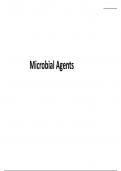
Microbial Agents Microbial Agents The agents of human infectious diseases belong to five major groups of organisms: bacteria, fungi, protozoa, helminths, and viruses. The bacteria belong to the prokaryote kingdom, the fungi (yeasts and molds) and prot
Microbial Agents Microbial Agents The agents of human infectious diseases belong to five major groups of organisms: bacteria, fungi, protozoa, helminths, and viruses. The bacteria belong to the prokaryote kingdom, the fungi (yeasts and molds) and protozoa are members of the kingdom of protists, and the helminths (worms) are classified in the animal kingdom. The protists are distinguished from animals and plants by being either unicellular or relatively simple multicellular organ...
- Summary
- • 28 pages •
Microbial Agents Microbial Agents The agents of human infectious diseases belong to five major groups of organisms: bacteria, fungi, protozoa, helminths, and viruses. The bacteria belong to the prokaryote kingdom, the fungi (yeasts and molds) and protozoa are members of the kingdom of protists, and the helminths (worms) are classified in the animal kingdom. The protists are distinguished from animals and plants by being either unicellular or relatively simple multicellular organ...
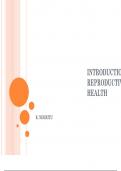
INTRODUCTION TO REPRODUCTIVE HEALTH R. NDERITU Reproductive Health Reproductive health is defined as a state of complete physical, mental, emotional and social well-being and not merely absence of disease or infirmity, in all matters relating to
INTRODUCTION TO REPRODUCTIVE HEALTH R. NDERITU Reproductive Health Reproductive health is defined as a state of complete physical, mental, emotional and social well-being and not merely absence of disease or infirmity, in all matters relating to the reproductive health system and to its functions and processes, (ICPD, 1994). Reproductive health care Reproductive health care is the appropriate constellation of methods, technologies and services that will ensur...
- Class notes
- • 43 pages •
INTRODUCTION TO REPRODUCTIVE HEALTH R. NDERITU Reproductive Health Reproductive health is defined as a state of complete physical, mental, emotional and social well-being and not merely absence of disease or infirmity, in all matters relating to the reproductive health system and to its functions and processes, (ICPD, 1994). Reproductive health care Reproductive health care is the appropriate constellation of methods, technologies and services that will ensur...
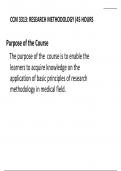
CCM 3313: RESEARCH METHODOLOGY (45 HOURS Purpose of the Course The purpose of the course is to enable the learners to acquire knowledge on the application of basic principles of research methodology in medical field. Expected Learning Outcome • At
CCM 3313: RESEARCH METHODOLOGY (45 HOURS Purpose of the Course The purpose of the course is to enable the learners to acquire knowledge on the application of basic principles of research methodology in medical field. Expected Learning Outcome • At the end of the course the learner should be able to • Explain the process of identifying research problems and prioritization. • Explain various components of research project in health • Explain the interrelationship of t...
- Class notes
- • 34 pages •
CCM 3313: RESEARCH METHODOLOGY (45 HOURS Purpose of the Course The purpose of the course is to enable the learners to acquire knowledge on the application of basic principles of research methodology in medical field. Expected Learning Outcome • At the end of the course the learner should be able to • Explain the process of identifying research problems and prioritization. • Explain various components of research project in health • Explain the interrelationship of t...

CCM 3314: CLINICAL PHARMACOLOGY AND THERAPEUTICS I (3 Credit Hours) Course Purpose To enable the students with knowledge, skills and attitude in pharmacology and therapeutics to manage diseases and disorders. Expected Learning Outcomes At the end of
CCM 3314: CLINICAL PHARMACOLOGY AND THERAPEUTICS I (3 Credit Hours) Course Purpose To enable the students with knowledge, skills and attitude in pharmacology and therapeutics to manage diseases and disorders. Expected Learning Outcomes At the end of this course, the student should be able to: 1. Explain principles and concepts in clinical pharmacology and therapeutics. 2. Classify various pharmacological and therapeutic agents as used in clinical practice. 3. Write and describe...
- Class notes
- • 68 pages •
CCM 3314: CLINICAL PHARMACOLOGY AND THERAPEUTICS I (3 Credit Hours) Course Purpose To enable the students with knowledge, skills and attitude in pharmacology and therapeutics to manage diseases and disorders. Expected Learning Outcomes At the end of this course, the student should be able to: 1. Explain principles and concepts in clinical pharmacology and therapeutics. 2. Classify various pharmacological and therapeutic agents as used in clinical practice. 3. Write and describe...
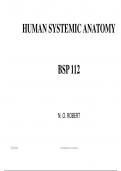
HUMAN SYSTEMIC ANATOMY BSP 112 N. O. ROBERT 9/26/2024 1 Introduction to anatomy Gross anatomy 9/26/2024 4 Introduction to anatomy 9/26/2024 5 Introduction to anatomy Course content Musculoskeletal Anatomy : Introduction 1. Anatomical posit
HUMAN SYSTEMIC ANATOMY BSP 112 N. O. ROBERT 9/26/2024 1 Introduction to anatomy Gross anatomy 9/26/2024 4 Introduction to anatomy 9/26/2024 5 Introduction to anatomy Course content Musculoskeletal Anatomy : Introduction 1. Anatomical positions of the body, axes, planes, common anatomical terminologies. 2. Connective tissue classification. 3. Bone-composition and functions, classification and types according to morphology and development. 9/26/2024 6 ...
- Class notes
- • 85 pages •
HUMAN SYSTEMIC ANATOMY BSP 112 N. O. ROBERT 9/26/2024 1 Introduction to anatomy Gross anatomy 9/26/2024 4 Introduction to anatomy 9/26/2024 5 Introduction to anatomy Course content Musculoskeletal Anatomy : Introduction 1. Anatomical positions of the body, axes, planes, common anatomical terminologies. 2. Connective tissue classification. 3. Bone-composition and functions, classification and types according to morphology and development. 9/26/2024 6 ...
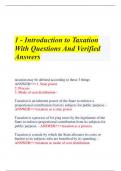
1 - Introduction to Taxation With Questions And Verified Answers taxation may be defined according to these 3 things ANSWER>>>1. State power 2. Process 3. Mode of cost distribution - Taxation is an inherent power of the State to
1 - Introduction to Taxation With Questions And Verified Answers taxation may be defined according to these 3 things ANSWER>>>1. State power 2. Process 3. Mode of cost distribution - Taxation is an inherent power of the State to enforce a proportional contribution from its subjects for public purpose. - ANSWER>>>taxation as a state power Taxation is a process of levying taxes by the legislature of the State to enforce proportional contri...
- Exam (elaborations)
- • 26 pages •
1 - Introduction to Taxation With Questions And Verified Answers taxation may be defined according to these 3 things ANSWER>>>1. State power 2. Process 3. Mode of cost distribution - Taxation is an inherent power of the State to enforce a proportional contribution from its subjects for public purpose. - ANSWER>>>taxation as a state power Taxation is a process of levying taxes by the legislature of the State to enforce proportional contri...
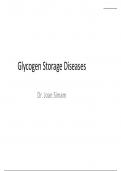
Glycogen Storage Diseases Dr. Joan Simam GSDs • Glycogen storage diseases – are rare (overall incidence 1 in 40,000), recessively inherited diseases in which the deficiency of a glycogen-degrading enzyme causes abnormal accumula on of glycogen. –
Glycogen Storage Diseases Dr. Joan Simam GSDs • Glycogen storage diseases – are rare (overall incidence 1 in 40,000), recessively inherited diseases in which the deficiency of a glycogen-degrading enzyme causes abnormal accumula on of glycogen. – Because different isoenzymes are present in different ssues, most deficiencies are limited to one or a few organ systems
- Summary
- • 5 pages •
Glycogen Storage Diseases Dr. Joan Simam GSDs • Glycogen storage diseases – are rare (overall incidence 1 in 40,000), recessively inherited diseases in which the deficiency of a glycogen-degrading enzyme causes abnormal accumula on of glycogen. – Because different isoenzymes are present in different ssues, most deficiencies are limited to one or a few organ systems

Healthcare
Nursing maternity healthcare
- Package deal
- • 4 items •
- 2024 Alpha Phi Alpha Fraternity Inc, IMDP Process - Week 1. Exam / Alpha Phi Alpha Fraternity Inc, IMDP • Exam (elaborations)
- HESI Exit Exam Test Bank 2024 NEWEST 2024 ACTUAL EXAM 500 QUESTIONS AND CORRECT DETAILED ANSWERS WITH RATIONALES (VERIFIED ANSWERS) |ALREADY GRADED A+ • Exam (elaborations)
- TEST BANK For Maternal Child Nursing Care 7th Edition Questions And 100% Verified Answers 2024 Updates • Exam (elaborations)
- ATI Nursing Care of Children Proctored exam 2024-2025 WITH CORRECT QUESTIONS AND ANSWER • Exam (elaborations)
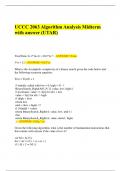
UCCC 2063 Algorithm Analysis Midterm with answer (UTAR)
UCCC 2063 Algorithm Analysis Midterm with answer (UTAR) True/False: Is 2^(n+1) = O(2^n) ? - ANSWER>>False 3^n + 12 - ANSWER>>O(2^n) What is the Asymptotic complexity of a binary search given the code below and the following recursion equation: T(n) = T(n/2) + 1 // initially called with low = 0, high = N - 1 BinarySearch_Right(A[0..N-1], value, low, high) { // invariants: value >= A[i] for all i < low value < A[i] for all i > high if (high ...
- Exam (elaborations)
- • 11 pages •
UCCC 2063 Algorithm Analysis Midterm with answer (UTAR) True/False: Is 2^(n+1) = O(2^n) ? - ANSWER>>False 3^n + 12 - ANSWER>>O(2^n) What is the Asymptotic complexity of a binary search given the code below and the following recursion equation: T(n) = T(n/2) + 1 // initially called with low = 0, high = N - 1 BinarySearch_Right(A[0..N-1], value, low, high) { // invariants: value >= A[i] for all i < low value < A[i] for all i > high if (high ...
